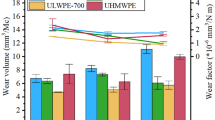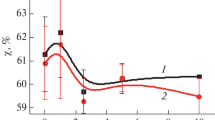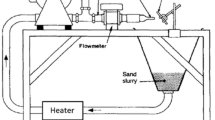Abstract
Ultra-high molecular weight polyethylene (UHMWPE) is one of the polymers with the best abrasive wear performance that exists, being used in engineering applications where this property is required. Despite its excellent property, UHMWPE still performs poorly in many applications. Therefore, the development of new materials with better properties is always very desirable. In this study, it is presented for the first time that it is possible to obtain polyethylene blends with better wear performance than UHMWPE. Linear polyethylenes, high-density polyethylene (HDPE), high molecular weight polyethylene (HMWPE) and UHMWPE, and blends, HMWPE-UHMWPE (10, 20 and 40 wt%), and HDPE-UHMWPE (20 and 40 wt%), have been studied here. The study was developed based on the correlation between the tensile test and the wear test of these materials. In 1968, Lancaster suggested that the abrasive wear resistance of polymers is strongly related to the product between the stress and strain at breaking obtained from the tensile test. This correlation is known as the Ratner–Lancaster correlation. Although this correlation is suitable for many polymers, it is not suitable for all. HDPE, HMWPE, and UHMWPE are examples of polymers where this correlation is not suitable. With the knowledge that the amorphous phase of polymers is responsible for wear resistance and ultimate tensile properties, a new and more suitable correlation for linear polyethylenes is suggested in this study. This correlation shows that the hardening modulus must be included as a factor to predict the abrasive wear resistance. The blends of HMWPE containing 10 and 20 wt% of UHMWPE showed volumetric loss after the wear test of 47.0 and 45.2 mm3, respectively, while UHMWPE presented a higher volumetric loss, of 55.7 mm3. The excellent performance of the blends was possibly due to a better understanding of the correlation between the tensile and abrasive tests proposed in this study.
Graphic abstract








Similar content being viewed by others
References
Lancaster JK (1968) Relationships between the wear of polymers and their mechanical properties. Proc Inst Mech Eng Conf Proc 183:98–106
Galetz MC, Blaβ T, Ruckdaschel H, Sandler JKW, Altstadt V, Glatzel U (2007) Carbon nanofibre-reinforced ultrahigh molecular weight polyethylene for tribological applications. J Appl Polym Sci 104:4173–4181. https://doi.org/10.1002/app
Liu F, Wang Y, Li K, Jiang L, Wang X, Shao X, Zhang B, Cui F (2015) Graphene oxide/ultrahigh molecular weight polyethylene composites: ball-milling preparation mechanical performance and biocompatibility effects. Am J Phys 1:51–57
Khruschov MM (1974) Principles of abrasive wear. Wear 28:69–88. https://doi.org/10.1016/0043-1648(74)90102-1
Kanagaraj S, Varanda FR, Zhil’tsova TV, Oliveira MSA, Simões JAO (2007) Mechanical properties of high density polyethylene/carbon nanotube composites. Compos Sci Technol 67:3071–3077. https://doi.org/10.1016/j.compscitech.2007.04.024
Srinath G, Gnanamoorthy R (2006) Two-body abrasive wear characteristics of Nylon clay nanocomposites-effect of grit size, load, and sliding velocity. Mater Sci Eng A. https://doi.org/10.1016/j.msea.2006.07.117
Morioka Y, Tsuchiya Y, Shioya M (2015) Correlations between the abrasive wear, fatigue, and tensile properties of filler-dispersed polyamide 6. Wear. https://doi.org/10.1016/j.wear.2015.07.003
Kurtz SM (2004) The UHMWPE handbook: ultra-high molecular weight polyethylene in total joint replacement. Elsevier, Amsterdam
Puértolas JA, Kurtz SM (2014) Evaluation of carbon nanotubes and graphene as reinforcements for UHMWPE-based composites in arthroplastic applications: a review. J Mech Behav Biomed Mater 39:129–145. https://doi.org/10.1016/j.jmbbm.2014.06.013
Xu S, Tangpong XW (2013) Review: tribological behavior of polyethylene-based nanocomposites. J Mater Sci 48:578–597. https://doi.org/10.1007/s10853-012-6844-x
Ferreira EHC, Fechine GJM (2020) Healing phenomenon adapted to understand the miscibility of polymer blends: an approach based on the deformation mechanism. J Appl Polym Sci. https://doi.org/10.1002/app.49604
ASTM D 3417-99 (1999) Standard test method for enthalpies of fusion and crystallization of polymers by differential scanning calorimetry (DSC) (Withdrawn 2004). ASTM International, West Conshohocken, PA
ASTM D638-14 (2014) Standard test method for tensile properties of plastics. ASTM International, West Conshohocken, PA. www.astm.org, n.d.
ISO 4649:2017 Rubber, vulcanized or thermoplastic: determination of abrasion resistance using a rotating cylindrical drum device, n.d.
Lucas ADA, Ambrósio JD, Otaguro H, Costa LC, Agnelli JAM (2011) Abrasive wear of HDPE/UHMWPE blends. Wear 270:576–583. https://doi.org/10.1016/j.wear.2011.01.011
Sheldon RP (1963) Density and degree of crystallinity in polymers. J Polym Sci B Polym Lett 1:655–657. https://doi.org/10.1002/pol.1963.110011202
Bower DI (2003) An introduction to polymer physics. Am J Phys. https://doi.org/10.1119/1.1533063
Špitalský Z, Bleha T (2003) Elastic moduli of highly stretched tie molecules in solid polyethylene. Polymer (Guildf) 44:1603–1611. https://doi.org/10.1016/S0032-3861(02)00908-4
Seguela R (2005) Critical review of the molecular topology of semicrystalline polymers: the origin and assessment of intercrystalline tie molecules and chain entanglements. J Polym Sci B Polym Phys 43:1729–1748. https://doi.org/10.1002/polb.20414
Fan Z, Wang Y, Bu H (2003) Influence of intermolecular entanglements on crystallization behavior of ultra-high molar mass polyethylene. Polym Eng Sci 43:607–614
Dimarzio EA, Guttman CM, Hoffman JD (1979) Is crystallization from the melt controlled by melt viscosity and entanglement effects? Faraday Discuss Chem Soc 68:210–2017
Bracco P, Bellare A, Bistolfi A, Affatato S (2017) Ultra-high molecular weight polyethylene: influence of the chemical, physical and mechanical properties on thewear behavior a review. Mater (Basel). https://doi.org/10.3390/ma10070791
Brown HR, Russell TP (1996) Entanglements at polymer surfaces and interfaces. Macromolecules 29:798–800. https://doi.org/10.1021/ma951123k
Bartczak Z (2017) Deformation of semicrystalline polymers: the contribution of crystalline and amorphous phases. Polimery 62:787–799. https://doi.org/10.14314/polimery.2017.787
Egan BJ, Delatycki O (1995) The morphology, chain structure and fracture behaviour of high-density polyethylene: part I fracture at a constant rate of deflection. J Mater Sci 30:3307–3318. https://doi.org/10.1007/BF00349874
Klapperich C, Komvopoulos K, Pruitt L (1999) Tribological properties and microstructure evolution of ultra-high molecular weight polyethylene. J Tribol 121:394–402. https://doi.org/10.1115/1.2833952
Tervoort TA, Visjager J, Smith P (2002) On abrasive wear of polyethylene. Macromolecules 35:8467–8471. https://doi.org/10.1021/ma020579g
Galetz MC, Glatzel U (2010) Molecular deformation mechanisms in UHMWPE during tribological loading in artificial joints. Tribol Lett 38:1–13. https://doi.org/10.1007/s11249-009-9563-y
Crist B, Fisher CJ, Howard PR (1989) Mechanical properties of model polyethylenes: tensile elastic modulus and yield stress. Macromolecules 22:1709–1718. https://doi.org/10.1021/ma00194a035
Galeski A (2003) Strength and toughness of crystalline polymer systems. Prog Polym Sci 28:1643–1699. https://doi.org/10.1016/j.progpolymsci.2003.09.003
Bowden PB, Young RJ (1974) Deformation mechanisms in crystalline polymers. J Mater Sci 9:2034–2051. https://doi.org/10.1007/BF00540553
Bartczak Z, Kozanecki M (2005) Influence of molecular parameters on high-strain deformation of polyethylene in the plane-strain compression. Part II. Strain recovery. Polym (Guildf) 46:10339–10354. https://doi.org/10.1016/j.polymer.2005.07.096
Friedrich K (1983) Crazes and shear bands in semi-crystalline thermoplastics. Adv Polym Sci. https://doi.org/10.1007/BFb0024059
Kausch H-H, Gensler R, Grein C, Plummer CJG, Scaramuzzino P (1999) Crazing in semicrystalline thermoplastics. J Macromol Sci B Phys 38:803–815. https://doi.org/10.1080/00222349908248140
Scharauwen BAG (2003) Deformation and failure of semi-crystalline polymer systems: influence of micro and molecular structure. Tech Univ Eindhoven
Pawlak A (2014) Plastic deformation and cavitation in semicrystalline polymers studied by X-ray methods. Polimery 59:533–541. https://doi.org/10.14314/polimery.2014.533
Pawlak A, Gałeski A (2011) Cavitation during tensile drawing of semicrystalline polymers. Polimery 56:627–636. https://doi.org/10.1021/ma201090z
Pawlak A, Galeski A (2008) Cavitation during tensile deformation of polypropylene. Macromolecules 41:2839–2851
Chan C, Wu J, Li J, Cheung Y (2002) Polypropylene/calcium carbonate nanocomposites. Polym (Guildf) 43:2981–2992
Briscoe BJ, Sinha SK (2013) Tribological applications of polymers and their composites: past, present and future prospects. In: Friedrich K, Schlarb AK (eds) Trybology polymer nanocomposites, pp 1–14. Elsevier, Amsterdam doi:https://doi.org/10.1016/S1572-3364(08)55001-4.
Xue Y, Wu W, Jacobs O, Scha B (2006) Tribological behaviour of UHMWPE/HDPE blends reinforced with multi-wall carbon nanotubes. Polym Test 25:221–229. https://doi.org/10.1016/j.polymertesting.2005.10.005
Acknowledgements
The authors would like to acknowledge Fundação de Amparo a Pesquisa de São Paulo (FAPESP) for the grants 2018/10910-8 and 2019/13416-7. The authors also thank Braskem for the supply of polymers. The correspondent author also has a researcher scholarship supported by CNPq (Conselho Nacional de Desenvolvimento Científico e Tecnológico), grant 307665/2018–6. The authors are grateful to Mrs Camilla Thais de Meneses Coelho for the images for the Graphic Review.
Author information
Authors and Affiliations
Corresponding author
Additional information
Publisher's Note
Springer Nature remains neutral with regard to jurisdictional claims in published maps and institutional affiliations.
Supplementary Information
HDPE, HMWPE, UHMWPE and blends DSC curves and the crystallinity degree calculated from the DSC analyses. Tensile toughness and volumetric loss results of the HMWPE, HMWPE-UHMWPE (10, 20 and 40 wt%) blends, and UHMWPE SEM images of cryogenic fracture surfaces of HMWPE-UHMWPE (20 wt%) blend. Below is the link to the electronic supplementary material.
Rights and permissions
About this article
Cite this article
Ferreira, E.H.C., Fechine, G.J.M. High abrasive wear resistance polyethylene blends: an adapted Ratner–Lancaster correlation. Polym. Bull. 79, 3631–3648 (2022). https://doi.org/10.1007/s00289-021-03680-3
Received:
Revised:
Accepted:
Published:
Issue Date:
DOI: https://doi.org/10.1007/s00289-021-03680-3




